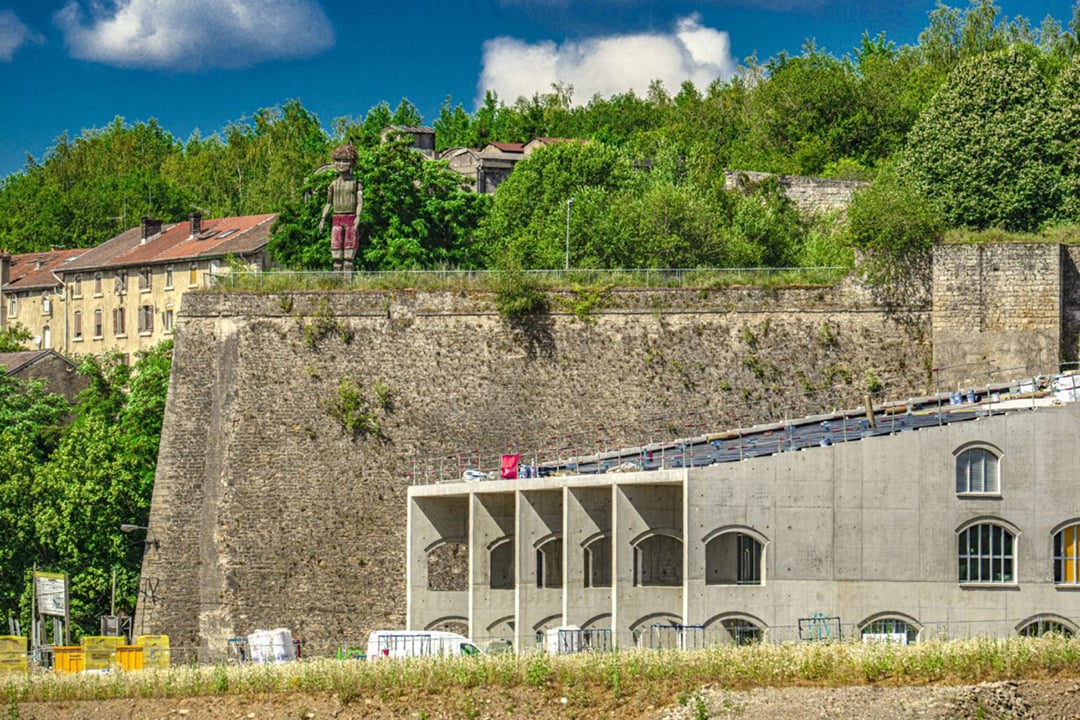
March 31, 2022
Esch2022 Celebrates One of Europe’s Most Stunning Industrial Turnarounds
“This initiative marks a transformation from an industrial society to a society of knowledge.”
Nancy Braun
130 cultural projects are now either underway or recently completed in post-industrial areas in and around Esch, extending all the way to parts of France. The Esch2022 program—spanning 170 square miles—also comprises the acquisition and refurbishment of existing historical buildings. The initiative aims to encourage “a transformation from an industrial society to a society of knowledge,” explains Nancy Braun, director general of Esch2022. Esch learned of its designation in 2017, says Braun, and the Esch2022 project (and its promise to bring life, culture, art and events to the Belval district) contributed to the state investing in numerous new built projects, on top of what was already underway.
Esch’s largest reuse development is Belval, a residential and business district two miles west of the Esch city center that sprawls across acres of former brownfields and successfully integrates two gigantic (300-foot-tall) decommissioned blast furnaces. Considered state-of-the-art when unveiled in 1979, the two furnaces (once three, until one was sold and shipped off to China) were decommissioned in 1993. Today, reigning benevolently over several new restaurants, they’re surprisingly majestic in their poignant acknowledgement of industrial days gone by, perhaps because they’re softened by elegant light features, gardens of colorful swamp grasses, and reflecting pools by landscape architect Michel Desvigne. For those willing to climb 180 steps straight up, a tour concludes with sweeping views of the distinctive urban landscape and nearby farmland.

Belval’s first building following the decommission was the Rockhal, completed in 2005. Now Luxembourg’s largest concert venue, it holds up to 6,500 people in its biggest hall and 1,200 people in an adjoining room. Six rehearsal rooms, a recording studio, and a media library are also on hand to encourage fresh talent. During Esch2022, the Rockhal will present “The Sound of Data: Science Meets Music,” a collaborative project transforming data into an electronic music concert.
The Cité des Sciences, a science campus for the University of Luxembourg adjacent to the blast furnaces, came next in Belval’s transformation. At its heart is the 670,000-square-foot Maison du Savoir (House of Knowledge). Designed by Baumschlager Eberle Architekten and Christian Bauer & Associés Architectes and completed in 2015, it incorporates classrooms and administrative offices. Its sister building, completed in 2018, is the university library, the 200,000-square-foot Maison du Livre (House of Books) by Valentiny Hvp Architects. Also open to the public, it’s stacked with some 800,000 books, with more than 1,000 workstations meeting diverse research or studying requirements.

Opposite the Rockhal at Massenoire, one of two industrial sites converted into exhibition and event venues, an audiovisual journey takes visitors through the history of Luxembourg’s iron and steel industry as well as the development of the new university quarter in “Remixing Industrial Pasts.” A collaboration between architecture firms Tokonoma and 2F Architettura and the Luxembourg Centre for Contemporary and Digital History (C2DH) at the University of Luxembourg, the exhibition is on view through May 15.
Across the border in Micheville, Villerupt, France, a new cultural center designed by K Architectures opened this January. Built on the site of a former steel furnace, L’Arche pays homage to Villa Malaparte, a house with distinctive red stonework on the Italian island of Capri. It contains two theaters (one with nearly 700 seats, and then a smaller 150-seat cinema), as well as recording studios and a digital exhibition space. Upcoming events include a film screening with live music by the Philharmonie Luxembourg, taking place as part of the 2022 Villerupt Italian Film Festival; an acrobatic dance project; open-air film screenings; and monthly “Repair cafes,” with experts on-hand to fix broken domestic tools such as vacuums.

In the center of Esch, a hollowed-out former furniture store is now home to a 26,000-square-foot contemporary art museum. Inaugurated in October, Konschthal Esch—a Space for Contemporary Art is Brutalist in form, with four levels of concrete slabs held up by raw metal beams. Its design is by the museum’s artistic director, Christian Mosar, in collaboration with the Division of Architecture of the City of Esch-sur-Alzette. “Filip Markiewicz: Instant Comedy,” a presentation of the local artist’s paintings and sculptures, will address the themes of overexposure and judgment in social media, through May 22.
After a renovation and expansion that includes a new annex by Luxembourg architect Jim Clemes housing temporary and permanent exhibition space and administration offices, the National Museum of Resistance and Human Rights, also in the Esch city center, is expected to reopen April 1. At nearly 9,400 square feet, the new facility is almost triple its previous size.
One notable element of Esch’s industrial past is visible only on Google Maps. A river appears to flow directly through the city center on the app – yet you won’t find it. The Alzette, which gave the city its name, actually runs below the city in an underground canal before reemerging at its outskirts. “It was paved over because it smelled,” a tour guide reveals.
For a full listing of Esch 2022 events, click here.
Would you like to comment on this article? Send your thoughts to: [email protected]
Related
Projects
The Project That Remade Atlanta Is Still a Work in Progress
Atlanta’s Beltline becomes a transformative force—but as debates over transit and displacement grow, its future remains uncertain.
Profiles
WAI Architecture Think Tank Approaches Practice as Pedagogy
Nathalie Frankowski and Cruz García use their practice to help dismantle oppressive systems, forge resistance spaces, and reimagine collective futures.
Products
Functional Beauty: Hardware That Does More Than Look Good
Discover new standout pieces that marry form and function, offering both visual appeal and everyday practicality.













